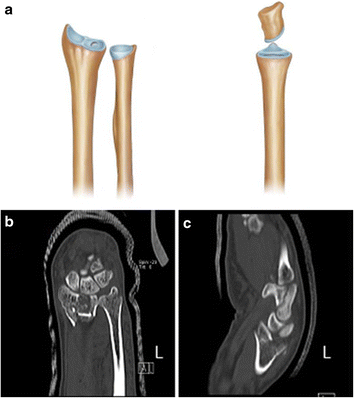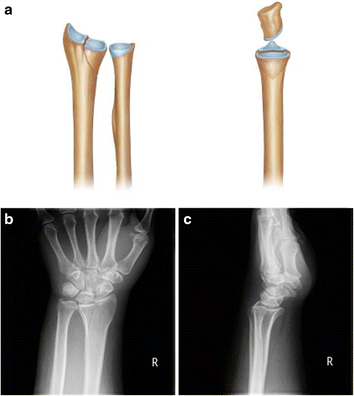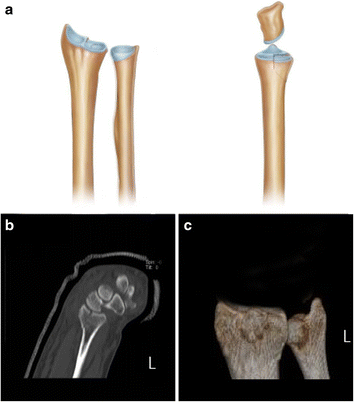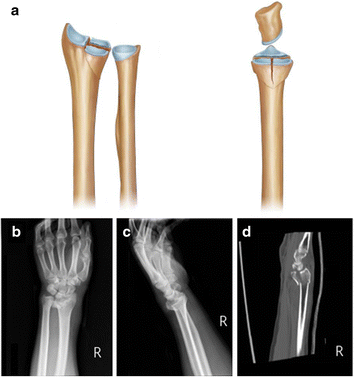New classification of lunate fossa fractures of the distal radius
- PMID: 27765057
- PMCID: PMC5073951
- DOI: 10.1186/s13018-016-0455-1
New classification of lunate fossa fractures of the distal radius
Abstract
Background: A die-punch fracture is a depression fracture of the lunate fossa of the distal radius. We propose a morphological classification of die-punch fractures that includes five types: center depression fractures, vertical depression fractures, volar depression fractures, dorsal depression fractures, and double die-punch fractures.
Methods: The radiographs of 112 die-punch fractures treated between January 2005 and January 2015 were retrospectively reviewed. The clinical images were examined independently for two rounds by six orthopedists with different clinical experiences: two residents, two attending physicians, and two consultants. A category-specific kappa score and a kappa score for more than two observers were analyzed. We used Cohen's kappa to test intraobserver variation.
Results: The kappa score for interobserver reliability was 0.69 for the first round and 0.70 for the second round. The intraclass correlations were 0.65 and 0.63, respectively. Intraobserver reproducibility using Cohen's kappa test was satisfactory. All of the results indicated a kappa value >0.4, suggesting good agreement within, as well as between, observers.
Conclusions: The outcome was assessed using kappa statistics, which showed good interobserver reliability and intraobserver reproducibility.
Keywords: Classification; Die-punch fracture; Radius.
Figures





Similar articles
-
Do 3-D Printed Handheld Models Improve Surgeon Reliability for Recognition of Intraarticular Distal Radius Fracture Characteristics?Clin Orthop Relat Res. 2020 Dec;478(12):2901-2908. doi: 10.1097/CORR.0000000000001356. Clin Orthop Relat Res. 2020. PMID: 32667759 Free PMC article.
-
Reliability of distal radius fracture classification systems: a CT based study.Emerg Radiol. 2024 Dec;31(6):873-879. doi: 10.1007/s10140-024-02294-2. Epub 2024 Nov 5. Emerg Radiol. 2024. PMID: 39499384
-
Classification of distal radius fractures: an analysis of interobserver reliability and intraobserver reproducibility.J Hand Surg Am. 1996 Jul;21(4):574-82. doi: 10.1016/s0363-5023(96)80006-2. J Hand Surg Am. 1996. PMID: 8842946
-
Is it really necessary to restore radial anatomic parameters after distal radius fractures?Injury. 2014 Dec;45 Suppl 6:S21-6. doi: 10.1016/j.injury.2014.10.018. Epub 2014 Oct 27. Injury. 2014. PMID: 25457314 Review.
-
Adult distal radius fractures classification systems: essential clinical knowledge or abstract memory testing?Ann R Coll Surg Engl. 2016 Nov;98(8):525-531. doi: 10.1308/rcsann.2016.0237. Epub 2016 Aug 11. Ann R Coll Surg Engl. 2016. PMID: 27513789 Free PMC article. Review.
Cited by
-
Morphological characteristics of different types of distal radius die-punch fractures based on three-column theory.J Orthop Surg Res. 2019 Nov 27;14(1):390. doi: 10.1186/s13018-019-1453-x. J Orthop Surg Res. 2019. PMID: 31775810 Free PMC article.
-
Influence of volar margin of the lunate fossa fragment fixation on distal radius fracture outcomes: A retrospective series.World J Clin Cases. 2021 Aug 26;9(24):7022-7031. doi: 10.12998/wjcc.v9.i24.7022. World J Clin Cases. 2021. PMID: 34540957 Free PMC article.
-
Identification of a novel three-column classification for double-column die-punch fractures of the distal radius.Exp Ther Med. 2020 Mar;19(3):1871-1877. doi: 10.3892/etm.2020.8434. Epub 2020 Jan 8. Exp Ther Med. 2020. PMID: 32104243 Free PMC article.
-
Open Reduction and Internal Fixation by Volar Locking Plates and the "Poking Reduction" Technique in Distal Radius Fractures with Displaced Dorsal Ulnar Fragments: A Retrospective Study.Orthop Surg. 2022 Oct;14(10):2489-2498. doi: 10.1111/os.13468. Epub 2022 Aug 26. Orthop Surg. 2022. PMID: 36017756 Free PMC article.
References
-
- Cooney WP. Fractures of the distal radius. A modern treatment-based classification. Orthop Clin North Am. 1993;24:211–216. - PubMed
-
- Fernandez DL, Jupiter JB. Fractures of the distal radius. New York: Springer; 1996.
-
- Audige L, Bhandari M, Hanson B, Kellam J. A concept for the validation of fracture classifications. J Orthop Trauma. 2005;19(6):401–406. - PubMed
MeSH terms
LinkOut - more resources
Full Text Sources
Other Literature Sources
Medical

